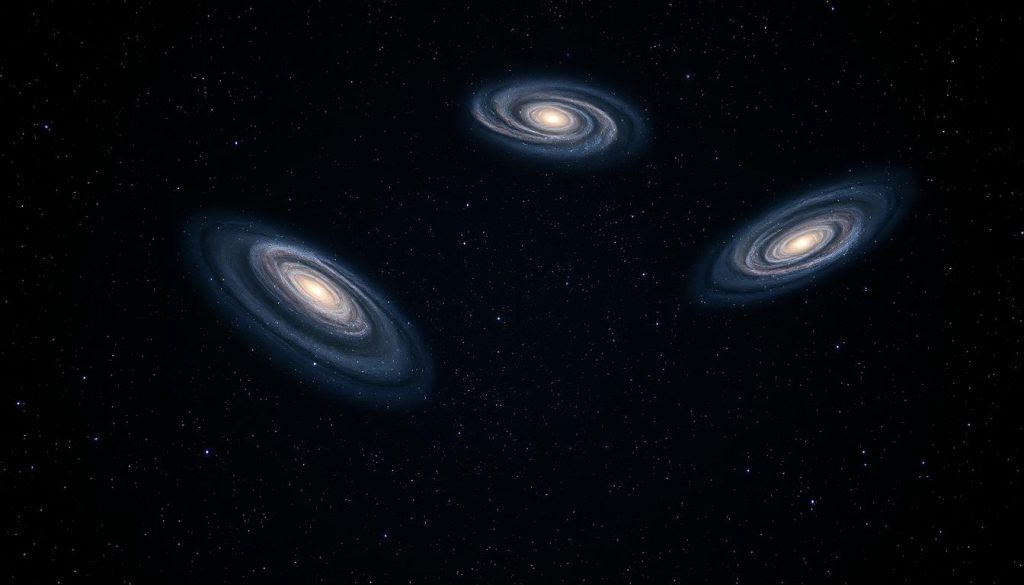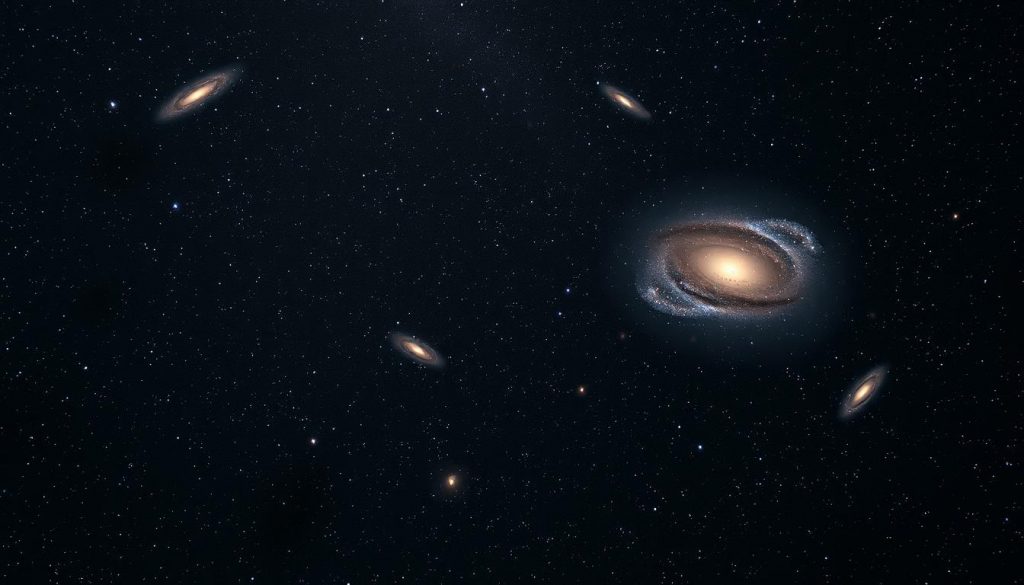Low surface brightness galaxies: the ghosts of the universe.
Low surface brightness galaxies (LSBs) are seen as cosmic enigmas. They are so dim, they’re hard to spot. Unlike normal galaxies, LSBs are much fainter, posing a challenge for scientists.
Anúncios
These galaxies are hidden in vast space. They offer key clues about how galaxies form and change over time.
New tools in astronomy are helping us learn more about LSBs. Large surveys and better imaging are uncovering their secrets. This research deepens our cosmic understanding and sparks curiosity about the universe’s mysteries.
Introduction to Low Surface Brightness Galaxies
Low surface brightness galaxies (LSBs) are a special group of objects in space. They are known for being hard to spot because they are so faint. This introduction to low surface brightness galaxies explains why they are tricky to find and study.
LSBs are big and glow softly, making them hard to see against the vast background of the universe. This makes them a challenge to study in terms of cosmic visibility.
Recent research has found many LSBs. There are 42 galaxies that are really big and bright, but still not very easy to see. Among these, 20 were new discoveries. RCP 32 is especially faint, with a size of 23.0 arcseconds and a brightness of 28.6 mag arcsec−2.
The characteristics of LSBs go beyond just how bright they are. Studies show they are connected to other structures in space, like the one around NGC 1052. There are more large LSBs near this area, especially those bigger than 15 arcseconds.
Even though LSBs are common, they only make up about 10% of what we can see in the universe. Yet, they make up 30% to 60% of all galaxies. It’s hard to see them, especially when they are very faint, over 26 mag arcsec−2. New methods, like deep learning, are helping, but they’re not as good as humans yet.
Studying LSBs is key to understanding the universe. Scientists are trying to figure out what the universe is made of and how it has changed over time.
The Characteristics of Low Surface Brightness Galaxies
Low surface brightness galaxies are unique. They have large sizes and low brightness at their centers. Their faintness makes them hard to spot, needing special tools to find them.
Understanding these galaxies is key. They often don’t have a clear shape, making them hard to study. Surveys like the SDSS show that finding them gets harder as they get fainter.
These galaxies are important for science. They challenge old ideas and help us learn more about the universe. For example, RCP 32 is one of the faintest galaxies found, showing how little we know.

Studying these galaxies helps us understand the universe better. New methods like deep learning are helping us find them more easily. This shows how diverse the universe is.
| Property | Value |
|---|---|
| Surface Brightness Detection Limit | ~24 mag arcsec² |
| Percentage of LSBGs (down to 10⁸ M☉) | ~50% |
| Percentage of LSBGs (down to 10⁷ M☉) | ~85% |
| Extreme LSBG Example (RCP 32) | reff = 23.0 arcseconds, ⟨μg⟩eff = 28.6 mag arcsec−2 |
| Accuracy of Deep Learning in LSBG Detection | ~90% |
Importance of Optical Field Surveys
Optical field surveys are key in detecting low surface brightness galaxies. They help astronomers gather data on these hard-to-find objects. By using advanced tools and imaging, we’ve learned a lot about galaxy shapes and how they change over time.
Big surveys use astronomical survey methods to find these galaxies over huge areas. For example, Schmidt plates and deep sky imaging help spot these faint galaxies. They also make our catalogs more detailed. The Uppsala General Catalog of Galaxies shows how gathering more LSB galaxies is possible without strict brightness rules.
Recent surveys, like the LSST, can spot millions of dwarf galaxies far away. This lets us study how these galaxies interact and how their environment affects them. Optical field surveys are crucial for understanding these interactions and how galaxies change.
These surveys help us find galaxies we wouldn’t see otherwise. Dwarf galaxies, especially those that interact, are important for star formation. They show that about 10% of star formation happens in these galaxies. Optical field surveys are essential for finding and studying these galaxies. For more on galaxy shapes and survey successes, check out this study.
Cosmological Significance of Low Surface Brightness Galaxies
Low surface brightness galaxies (LSBGs) are key to understanding our universe. They make up a big part of the galaxy count, especially at redshift z = 0. Research shows they might help us understand dark matter and the universe’s mass.
Studies say LSBs are important for creating big cosmic structures. They help us see how galaxies form in low-density areas. LSBs live in the outer parts of galaxy clusters and groups, offering a unique view of their growth.
LSBGs start forming stars later than bright galaxies. This shows how star formation changes over time. New surveys have found more LSBs, showing there’s still a lot to learn. New methods can spot LSBs with high accuracy, making future studies easier.

Studying LSBs helps us understand the universe better. They are crucial for future research on galaxy evolution. The study of these faint galaxies will continue to be important, helping us understand the cosmos.
The Density of Low Surface Brightness Galaxies
The density of low surface brightness galaxies shows a fascinating cosmic landscape. It highlights their often underestimated abundance in the universe. Recent discoveries found 42 LSBGs, especially those with an effective radius over 5 arcseconds and a surface brightness above 24 mag arcsec−2.
Twenty of these galaxies were found near NGC 1052. This discovery expands our understanding of their distribution.
Research shows that large LSBGs, with an effective radius over 15 arcseconds, are mostly found near NGC 1052. The galaxy RCP 32 is a standout with an effective radius of 23.0 arcseconds and an average surface brightness of 28.6 mag arcsec−2. This shows some of the lowest surface brightness levels detected.
This highlights that LSBGs might be more common than thought. Traditional definitions usually set these galaxies at a brightness of 22 mag arcsec−2.
However, there are challenges in measuring the density of these galaxies. Getting radial velocities for LSBGs is hard due to time limits and their faintness. Magnitudes often exceed 26 mag arcsec−2.
Different studies show that density can vary a lot across scales, especially between 2 and 5 Mpc. This points to important differences in environmental conditions for both low-mass and more massive LSBs.
| Galaxy | Effective Radius (arcseconds) | Average Surface Brightness (mag arcsec−2) | Location |
|---|---|---|---|
| RCP 32 | 23.0 | 28.6 | NGC 1052 |
| Detected LSBGs | ≥ 5 | ≥ 24 | Various |
| Newly Discovered LSBGs | N/A | N/A | NGC 1052 Region |
Exploring the density of low surface brightness galaxies continues to reveal these hidden cosmic entities. It shows their role in galaxy formation and cosmic evolution. As studies progress, we will gain a clearer picture of LSBGs and their environments. This will deepen our understanding of their significance in the universe.
Challenges in Studying Low Surface Brightness Galaxies
Studying low surface brightness galaxies (LSBs) is tough. Their dimness makes them hard to spot and study. It’s also hard to know where they are because we don’t fully understand their distribution.
Recently, scientists found 42 LSBGs, with 20 being new discoveries. This shows how rare data on these galaxies is.
Getting accurate data is another big problem. It’s hard to measure how fast LSBGs move away from us. The way we classify LSBGs has changed, making it even harder to find them.
Now, scientists use special software to help find LSBGs. This software uses deep learning and can spot false positives with about 90% accuracy.
To study LSBs, scientists need to find new ways to overcome these challenges. Knowing where LSBs are is key. They are thought to be part of a big structure around NGC 1052.
Even though we can only see about 10% of LSBs, they are important. Learning more about them helps us understand the universe better.
| Study/Survey | New LSBGs Detected | Accuracy of Detection | Density Increase |
|---|---|---|---|
| Sloan Digital Sky Survey | 4083 | Approximately 94% | 5.5 deg−2 |
| Hyper Suprime-Cam Subaru Strategic Program | 781 | About 4% confirmed after inspection | N/A |
| Dark Energy Survey | 17% increase from previous observations | 90% for machine learning classification | N/A |
Future Directions in Low Surface Brightness Galaxy Research
The study of low surface brightness galaxies is set to get a boost. New imaging technologies will help astronomers see more clearly. They aim to spot galaxies that are too faint for today’s tools.
By using deeper and more sensitive surveys, we’ll learn more about these galaxies. This will change how we understand them.
Researchers will also dive deeper into how these galaxies form. They want to know more about their environment and how they interact with others. This will help us understand galaxy formation better.
They will also study the matter inside these galaxies. This includes both the visible and invisible parts. It’s all about uncovering the secrets of LSBs.
We’re excited for the discoveries that will come from these new methods. They will improve our theories and how we observe the universe. This will help us understand LSBs and the universe better.
Scientists and institutions working together will make great progress. They will uncover the mysteries of low surface brightness galaxies. This will give us a deeper understanding of the universe’s structure and how it has evolved.
Conclusion
Low surface brightness galaxies, or LSBs, play a key role in understanding our universe. They are often seen as inactive, but they hold important clues about the universe’s creation and matter distribution. Studies, especially on NGC 6822, show the need for detailed observations to uncover their true nature.
These galaxies have unique traits like low star formation rates and high gas content. They might also play a big part in how our galaxy evolves. Their gas-rich nature and low mass suggest they could fuel future star births, showing a deeper role in the universe.
The study of LSBs is crucial for filling gaps in our cosmic knowledge. As scientists explore these galaxies, they will likely find new insights. These discoveries will change how we see the universe’s past and structure.
